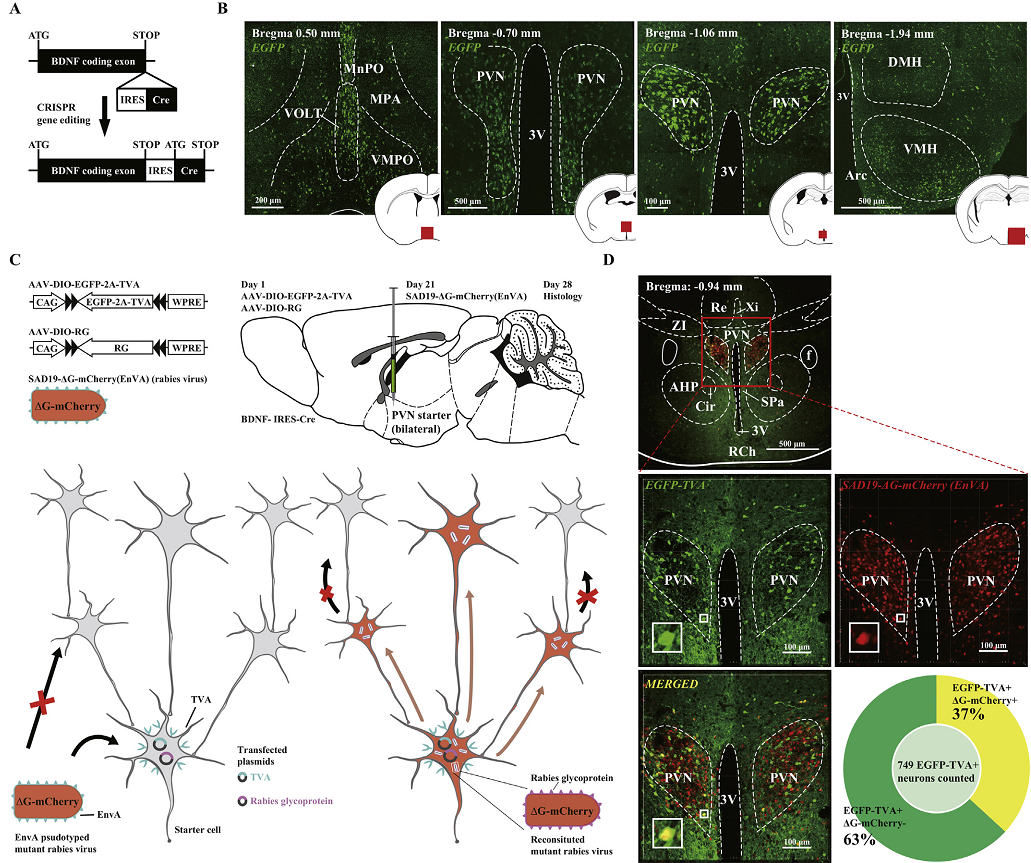An adeno-associated virus (AAV)-based fluorescent tracer was used to analyze the axon projection patterns of these neurons.
The viruses used in this article from BrainVTA are in the table below
|
RV |
R01004 SAD19-DG-mCherry(EnvA) |
|
Tracing Helper |
PT-0062 AAV-DIO-EGFP-2A-TVA
PT-0023 AAV-DIO-RG |
Fang Luo, Yuling Mu, Cuicui Gao, Yan Xiao, Qian Zhou, Yiqing Yang, Xinyan Ni, Wei L. Shen, Jiajun Yang
Pub Date: 2018-11-03,
DOI: 10.1016/j.jgg.2018.11.004,
Email: sales@brainvta.com
Brain-derived neurotrophic factor (BDNF) plays a crucial role in human obesity. Yet, the neural circuitry supporting the BDNF-mediated control of energy homeostasis remains largely undefined. To map key regions that might provide inputs to or receive inputs from the paraventricular nucleus (PVN) BDNF neurons, a key type of cells in regulating feeding and thermogenesis, we used rabies virus-based transsynaptic labeling and adeno-associated virus based anterograde tracing techniques to reveal their whole-brain distributions. We found that dozens of brain regions provide dense inputs to or receive dense inputs from PVN BDNF neurons, including several known weight control regions and several novel regions that might be functionally important for the BDNF-mediated regulation of energy homeostasis. Interestingly, several regions show very dense reciprocal connections with PVN BDNF neurons, including the lateral septum, the preoptic area, the ventromedial hypothalamic nucleus, the paraventricular thalamic nucleus, the zona incerta, the lateral parabrachial nucleus, the subiculum, the raphe magnus nucleus, and the raphe pallidus nucleus. These strong anatomical connections might be indicative of important functional connections. Therefore, we provide an outline of potential neural circuitry mediated by PVN BDNF neurons, which might be helpful to resolve the complex obesity network.

Figure. 1 Genetic labeling of BDNF neurons and transsynaptic tracing.
In this study, the authors systematically analyzed the inputs and outputs of PVN BDNF neurons using rabies virus-based transsynaptic retrograde labeling and AAV-mediated anterograde labeling (From
BrainVTA). They found several key regions thatmight be functionally relevant to the role of PVN BDNF neurons in energy balance control and outlined the circuits for further studies.
BrainVTA offers viral vector construction & virus packaging services for AAV, LV, RABV, PRV, HSV and VSV that help researchers explore questions about genes, neurons, circuitry structure, function of brain network, mechanism and treatment of diseases.
If you have any needs, just email us at
sales@brainvta.com.
